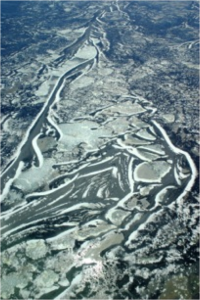Update from the Arctic #2: In Search of Knots
CWF’s Larry Niles is in Northern Canada searching for Red Knots and other shorebirds in their Arctic breeding territory. We are following him and posting summaries of his blog entries as he reports from the field.

While flying from Winnipeg to Nunavut, we focused on a strategy for finding red knot nests and adults with broods. We know from our 9 years of Arctic work that knots don’t occur randomly across the tundra landscape. Quite the opposite, they choose very specific places that distinguish knots from other Arctic nesting shorebirds.

Most knots choose to nest in relatively barren tundra slightly higher in elevation than more common Arctic nesting shorebirds. The latter prefer the lush wetland tundra along the coast and in the bigger river drainages because of the abundant prey early in the season. So why are knots drawn to colder and more barren places? We suspect they rely on the more persistent snow cover to discourage predation while they lie low in small patches of snow-free patches. Most predators prefer the lush areas with relatively dense shorebird nests. By the time the knot young hatch and are ready to feed, the protective snow barrier melts and the adults take their brood to the surrounding defrosted wetlands. By then shorebird prey are abundant.
So we suspect that at this point in the nesting season, we will find eggs just starting to hatch and soon the adults will lead their young to the nearby wetlands. Rick Lathrop, head of the Rutgers University Center for Remote Sensing and Spatial Analysis (CRSSA), has prepared mapping that will help us find prospective nest sites with the following characteristics:
- Areas with less than 5% vegetation (We will especially be looking for eskers, or sinuous frost-cracked rocky ridges that snake through the best knots habitats.)
- Numerous nearby patches of wetlands or small lakes with interconnecting streams
- Areas of slightly higher elevation that stay snowy longer into the season

We have several targets but we are not certain that we can get to them. We hope to drive into the interior areas of Southampton on a new road built to help residents access new fishing sites. We want to take a truck as far as possible to carry our supplies and equipment. At the road end we will still have to move everything with ATVs to the areas of greatest probability, which are likely to be about 10-20 miles off the new road. It’s hard to plan.
But the rewards are great. If we are successful we will be able to study red knot for the first time without the need of being flown in to a remote place at great expense. We shall see.
For the original blog entry, see Larry’s post here.
Stay tuned for further updates!
Discover more from Conserve Wildlife Foundation of NJ
Subscribe to get the latest posts sent to your email.